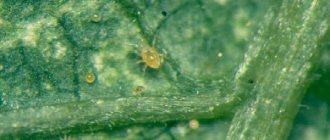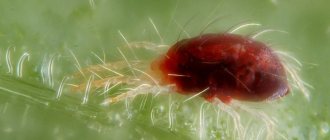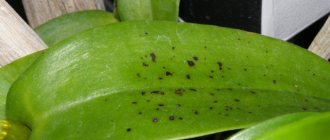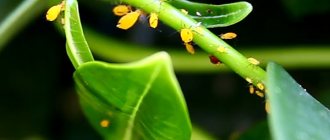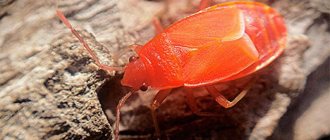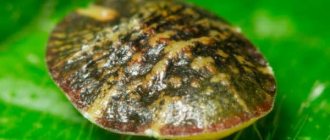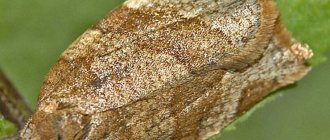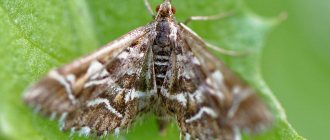What do mites look like on orchids?
Small pests with an elliptical, oval-shaped body, with 4 pairs of legs.
Length – 0.1-1.1 mm. Color depends on the type (whitish, black, brick, yellowish). Inconspicuous, they prefer to settle on the lower part of leaf blades, laying eggs along the way. If you do not pay attention to the flower, the population grows to catastrophic proportions. External signs of infection:
- small depressed gray blotches on the green part of the leaves;
- deformation, drying of the plates along the edges, characteristic silvery coating;
- thin-leaved - curl into a tube, turn yellow, fall off;
- rotten areas at the base of the plant;
- unusually short peduncles, brown spots on deformed flowers;
- web.
Optimal conditions for the appearance of mites on orchids
Spider mites prefer dry air and high temperatures, so they attack weakened plants kept in such conditions. They reproduce in closed ground when the thermometer is not lower than 12 degrees Celsius. About 20 generations are produced annually, the full development cycle of one generation lasts from 12 to 20 days, and it decreases with increasing air temperature. The optimal range is 28–32 degrees above zero with air humidity no more than 45–50%, when the complete transformation into an adult spider mite occurs in 6–6.5 days.
Flat beetles develop year-round in closed ground and do not show any special preferences for environmental conditions. Increasing air humidity, which slows down the development of spider mites, is not always effective for flat beetles.
The bulb mite develops more actively at high indoor temperatures, for example, at 26–28 degrees, the full cycle from egg to adult is 10–11 days, while at 20 degrees it takes more than 2 weeks.
Arthropods enter a room in several ways:
- with contaminated substrate;
- with a new specimen of the orchid collection purchased at a flower shop or arrived from a greenhouse;
- with a gust of wind through an open window;
- on the clothes of a person who stopped next to the affected plant.
How to get rid of it at home: control measures
At home, you can fight harmful insects using methods such as:
- It is necessary to isolate the plant from others and place the pot in a humid place, protected from direct sunlight. It should not be near a hot radiator or air conditioner, or in a draft.
- Treat the window sill where the orchid was located with disinfectants, paying special attention to the cracks.
It is best to use dishwashing detergent or powder, adding a couple of drops of potassium permanganate or ammonia. It is necessary to re-treat before putting the pot back in place. If you do not treat the window sill, the mites remaining on the window will return to the plant and lay eggs. - Treat the plant itself, let it sit for a couple of days, and then return it to its place.
There are quite a few methods of disinfection, from special chemicals to simple products that can be found in any kitchen. If the flower is slightly damaged, and the mite is mainly located on the leaves, you can use traditional methods:
- Place the plant under a plastic bag for a couple of days, after moistening it with a spray bottle. You should check the condition of the flower daily and re-spray if necessary.
- Treat the leaves with a damp cotton pad, carefully wiping the top and bottom surfaces of the leaf. The treatment should be repeated for at least 5 days.
- Wash the plant with water adding shavings of laundry soap in a ratio of 30g per 100 ml of water. You can also use dishwashing solutions by adding a tablespoon of product to 200 ml of warm water.
For some types of orchids with delicate leaves, treatment with compounds containing alcohol or ammonia is unacceptable, as it can damage not only the greenery, but also the roots.
No less popular are biological means of control using drugs such as Fitoverm and Akarin. Unfortunately, the fight against adult ticks will only be successful, but their eggs will not be harmed. To completely destroy the pest, it is recommended to treat the plant at least 3 times with a break of 5 days.
Chemical preparations such as Actellik, Antiklesch, Neoron and Fufanon ensure complete destruction of parasites due to the fact that they have a long-lasting effect (up to 7 days) and are also highly toxic to ticks. But at the same time they have a number of disadvantages such as:
- unpleasant odor;
- prohibition on use in the apartment;
- as well as the undesirability of use near apiaries.
You should not use chemical tick control agents in enclosed spaces, as this can be harmful to the health of humans and pets. When using such drugs, protective masks and gloves should be used.
Types of ticks
Unfortunately, spider pests are not the only mites that can be found on an orchid. Infection with flat beetles, as well as spider mites, but false ones, is quite often observed. This species does not spin webs and the reproduction process occurs under different conditions.
Before you begin pest control, you need to know what kind of mites the infection occurred, this is the only way to choose effective methods and achieve the desired result.
It is worth understanding that each type has its own characteristics. Some prefer humidity, while others, on the contrary, can reproduce only in warm and dry air. In order to create conditions that are not favorable for parasites, it is also necessary to know which individuals attack the orchid.
The most common ones include:
Ordinary
These arthropods have a soft body that is flat on the abdomen and convex on the back. An adult female specimen grows to a maximum size of 0.6 mm, male specimens are even smaller - 0.3-0.45 mm.
The larva has only 6 legs, it has a transparent body with a light green tint or may have a greenish color with a brown tint, and there are dark spots on both sides of the body. An adult female after wintering has an orange body with a red tint, and already has 4 pairs of legs.
Carmine
These individuals are distinguished by a rather remarkable body color; they can be dark red or burgundy-brown. The shape of the body is ellipsoidal. Eggs and larvae are red, and individuals in the nymphal stage are yellow with a light green tint.
Turkestan
They are very similar to the common tick, have the same body sizes and there are no differences in structure. They are yellow in color with a green tint; in females, with the arrival of spring, the color changes to bright red.
Flat (flat)
They have anatomical differences. Their body is divided transversely into anterior, middle and posterior parts. Next, we will present the types of flat beetles, as well as false spider pests, which are most often found on orchids.
Phalaenopsis
Individuals are very small in size and have a red body. An adult female grows to a maximum size of 0.3 mm, and males do not exceed a size of 0.27 mm. On the back of the body there are 2 antennal bristles. The eggs have an oblong shape and are red in color; the larvae do not differ in color, but have 3 pairs of legs.
It will be very difficult to see them on orchids, and this is not only because of their microscopic size. The fact is that they hide in very secluded places, near the base of the leaves, axils and folds.
Greenhouse
Individuals are egg-shaped and terracotta-red in color. There is a mesh pattern on the back. Regardless of the stage of development, they always have a red body color. For this reason, it is called the red flat mite.
Oncidium
They have an oval shape and an orange-reddish color, reaching a maximum size of 0.3 mm. The eggs are also reddish in color. In addition to causing damage to the plant, when pierced they release saliva, which contains toxins.
Bulbous
These arthropods live at the base of the stem or on the roots. It has a white color or with a yellow tint. Their paws are well developed.
Description and appearance
If we talk about spider mites, then it is worth saying that this is not a separate species, but a whole family, which includes 1270 species of pests. They are found anywhere in the world, but Antarctica with its harsh climate is not suitable for spider mites. Their diet consists of plant juice, which leads to weakening, diseases may appear, and if they are not eliminated, the flower will die.
These are microscopic pests, the size of which does not exceed 1 mm. They have an oval body shape. Depending on the type of spider mite, they have different colors of the body; there may be orange, yellow, white, red-brown individuals, some have dark spots on the back. They have 8 legs and a piercing-sucking mouthparts. You can see what it looks like in the photo.
The life cycle includes 5 stages of development. Females lay round eggs, which usually do not exceed 0.15 mm in diameter. They can be white or orange with a red tint. The egg clutches are located on the underside of the leaf, covered on top with a very thin web.
From the eggs, larvae emerge, which can be white or red in color, then they transition to the 2nd stage of the nymph, most often the individuals have a yellowish-green color. And the last stage of the imago is sexually mature individuals.
In addition to the fact that they suck out plant sap, which already causes enormous harm, ticks are also carriers of infections. One of the dangerous diseases that mites can infect an orchid with is gray rot.
Conditions of appearance and signs of damage
On phalaenopsis, root mites will multiply quickly when:
- dry air;
- high temperature;
- provided that the plant has a weakened immune system.
Experts have found that the spider feels comfortable when:
- temperature +28+32C;
- humidity less than 50%.
Flat-bodied ticks can develop in closed ground throughout the year, and they do not require special conditions. High humidity can only slow down the transformation of a small individual into an adult, but this process is inevitable.
Important! To prevent the plant from becoming infected with pests, it is forbidden to use contaminated planting substrate taken from the garden bed. Even if there is a need to use such soil, it must be prepared and processed.
Mites on an orchid are located to feed on the juices of the flower. This occurs by piercing the surface of the foliage or stems, through which the pest introduces a substance that can destroy the cell membrane. This helps to accelerate the secretion of juice and its release through the affected area, through which the spider feeds.
Through the hole made, air penetrates into the structure, and this leads to the transformation of green foliage into silver, it becomes covered with cobwebs. Soon the leaves will turn yellow, and the affected areas will quickly spread throughout the plant, causing them to fall off.
In some cases, cobwebs can be found not only on the foliage, but also on the surface of the buds. This is a sign of the presence of a large spider colonization, and if the orchid is not treated for mites, it will die. What will happen:
- gradual yellowing;
- curling the tips of the leaves;
- drying out;
- death of leaves and buds.
If the orchid is not treated, mites can cause a bacterial, viral or fungal disease, as evidenced by the presence of dark spots and weeping areas.
Symptoms of mite damage to orchids
Insect control measures should be chosen depending on the signs of the presence of a spider. It is too difficult for inexperienced gardeners to detect arthropods, especially without using optical instruments. Education can be considered a characteristic feature:
- Cobwebs are silvery or white on the underside of the leaves, which, when pressed, acquire a reddish tint and transform into a liquid substance.
- Small white spots on the surface of the leaf blade, which look like many injections made with a thin needle, which leads to the death of the affected tissue.
Note. Over time, the dots merge into brown spots, which is why the green areas die off. Injections can be seen in the area of the leaf axil; you need to regularly inspect the plant.
How to inspect a plant
The fight against spider mites on orchids begins with a thorough examination of the flower to detect parasites. They look different, and therefore it is worth studying all their forms. Since it is almost impossible to examine the spider, you need to pay attention to the following points:
- accumulation of insects on the back of the foliage;
- sudden decline for no reason;
- formation of large and white spots;
- white cobwebs throughout the plant;
- twisted and dried leaves.
Do not confuse black and white spots, as the former are a sign of fungus and mold. Having eliminated the fungus, you should not assume that the problem is solved, since the immune system is weakened and the colonies will begin to actively grow further. Parasites prefer young and succulent foliage, and therefore it is young plants that die.
What does a spider mite look like and what is dangerous?
You can get rid of spider mites on orchids only by knowing what they look like. This insect has:
- oval body 0.3-0.5 mm in size;
- color from red to green, but the chitinous cover can change shade depending on what is used as food;
- 4 pairs of legs, provided that the individual is an adult;
- average life expectancy of 5 weeks;
- 3 pairs of legs in small individuals;
- small area of movement.
Throughout its life, the insect creates the finest global webs that entangle foliage, stems and even buds. If treatment is not started, rapid reproduction will destroy the plant.
You need to get rid of spider mites on an orchid as quickly as possible. The main threat is that the pest:
- actively reproduces;
- has a high appetite;
- able to spread to neighboring plants;
- hides under the surface of the soil;
- lays larvae in fallen leaves.
How quickly a plant will die without assistance depends on the extent of the spread of mites along the stems. The general consequences are:
- a sharp decrease in photosynthesis;
- stem weakness.
Due to the fact that the exotic beauty is affected by such insects, this reduces immunity, which increases the likelihood of a bacterial or viral infection.
Note. If you do not fight the first signs, the disease will actively grow and the flower will die in a couple of weeks.
How and what harm does it cause to the plant?
Feeding on plant sap, mites pierce a leaf or stem . Air enters the puncture sites, the area around the source becomes covered with a silvery coating, and a cobweb forms.
The spider mite pierces the leaf, after which it begins to turn yellow.
The next stage occurs rapidly - yellowness appears , which very quickly spreads over the surface of the leaf plate and leads to the leaf falling off. The movement of parasites onto flowers and buds leads to their drying out and falling off.
Spider mites on orchids often provoke various types of infections :
- Fungal;
- Bacterial;
- Viral.
This is manifested by wet areas and dark spots.
What should I use to get rid of it?
How to deal with cobwebs?
Having discovered a spider mite on an orchid, you can begin to fight it in the following ways:
- Biological. It is enough to have several walls of predatory beetles or mites - they will help the grower get rid of small mites.
- Chemical. Insecticides are used. Moreover, the drugs need to be alternated, since the parasite develops immunity to insecticides.
- People's At the initial stage of spider mite development, you can use a decoction of cyclamen. Boil the roots for half an hour, leave for 24 hours. After this, pour the solution into a spray bottle and spray the orchid for 4-5 days, 3-4 times a day.
Bulbous
When a bulbous type of parasite appears, you must immediately change the soil in the flowerpot and disinfect the container. You can completely get rid of the bulb mite in the following ways:
- Folk. This method can be used only in the early stages of the appearance of the bulb mite. The best option is a solution of laundry soap (dilute 20 g of soap in a liter of warm water). Wipe the green surfaces of the flower with the finished mixture or immerse it completely in soapy water for 30-40 minutes.
- Chemical. In this case, broad-spectrum insecticides are used. However, you can also use narrowly targeted drugs that fight ticks specifically - acaricides. The cooking method is indicated on the package. The concentration can be made less, but in no case stronger, since the product can destroy the plant.
Reference! The biological option for controlling bulb mites is not suitable in this case.
Kornev
This type of tick is very difficult and takes a long time to remove. In addition, root pests are characterized by their ability to reproduce rapidly. As soon as you notice this pest on the surface of the plant, all affected parts must be removed immediately. Don't forget to treat the cut areas with activated carbon. Affected crops must be isolated from other healthy ones.
In addition, the following methods are used to combat root mites:
- People's A decoction of nettle will do (take 700 g of dry herb for 5 liters of water and leave it in a dark place all day). The orchid is sprayed with the product 4-5 times a week. The decoction will not only help get rid of pests, but also increase the protective functions of the plant.
- Chemical. Acaricides remain an option for controlling root mites. In addition, insectoacaricidal agents, for example, Acaritox, are a good way to combat pests. Use it strictly according to the instructions described at intervals of a week. Also effective drugs are the following: Verticillin, Nematofagin and Dachnik.
- Biological. Natural oils are suitable.
Flathead
This type of parasite is difficult to destroy, so it is best to start fighting them with chemicals. You need to choose acaricides, since insecticides will be ineffective in this case. Suitable chemicals:
- Actofik;
- Fitoverm;
- Vermitek.
In addition, you can use folk remedies, for example, soap solution. Rubbing the leaf plates with alcohol also helps.
Attention! Biological agents will not help in destroying the flatworm.
Armored
This pest reproduces in the soil, so you need to start fighting it immediately after detection. First of all, the orchid is taken out of the pot and soaked in water at room temperature for 30 minutes.
In a few minutes it will be noticeable how the parasites emerge. After 30 minutes, the plant must be removed from the water and dried. To obtain maximum effect, it is recommended to carry out 2-3 procedures.
The best chemicals are:
- Aktellik;
- Karbofos;
- as well as Sumiton.
In addition, you can buy predatory mites in the store , which will help get rid of parasites. One package will be enough for this.
What parts of the plant does it live on?
A favorite place is a place with enough food. Mainly :
- Leaf apparatus;
- Stem;
- Flowers.
By introducing a special substance into cell membranes, the movement of juice , which serves as nutrition and promotes reproduction, is accelerated.
Often a spider colony can be found on buds . The appearance of a colony on the buds indicates a large number of pests and the imminent death of the plant if appropriate control measures are not taken urgently.
Which parts of the flower are affected?
Depending on the family, mites settle in the substrate, on leaf blades, or at the growing point. Active life activity harms green mass, buds, peduncles, flowers, and roots.
Types of damage:
- in places of bites, the leaves lose juice along with chlorophyll cells. The damage gradually spreads to the entire flower, the plates acquire a marbled coating, turn brown, and finally dry out;
- living in the substrate, damage the root system. Feeding on plant tissue, large colonies turn roots into dust.
Peculiarity! A pest is a carrier of bacteria, fungi, and viruses. Along with damage from their vital activity, infectious lesions develop. The first sign is wet spots on the foliage.
How to deal with them?
To get rid of spider mites and other types of mites at home, you should take a number of effective measures. First of all, it is necessary to disinfect the affected area. You should use diluted laundry soap: one large spoon of liquid soap is mixed in one liter of water. Using a cloth or sponge, gently wipe the surface of the plant.
It is important that the soap solution does not get on the ground, otherwise the root system will be damaged. The tray and pot should be wiped with a disinfectant solution, and if the orchid is on the windowsill, then it is also advisable to wipe all the surfaces around with a soap solution.
After this, you should pour the substrate, cover the plant with a transparent film, and keep it in this form for at least 70 hours. The film increases the percentage of humidity, which promotes the active annihilation of insects and can cure the plant. It is important to remember that the orchid is afraid of direct sunlight; the flower should be kept in the shade.
Chemicals
The most effective drugs in the fight against ticks can be acaricides:
- "Aktofit";
- "Fitoverm";
- "Vertimek".
Special chemicals are often used against spider mites:
- "Aktellik";
- thiophos.
It is recommended to treat the plant with chemicals and at the same time create comfortable greenhouse conditions for it by covering it with a transparent film. The treatment should be done with one of the preparations, and only then use the film. It is also important to remember that ticks are resistant parasites and are able to quickly produce an antidote. From time to time you will have to alternate chemical compositions.
The most dangerous mite is considered to be the root mite. If signs of infection appear, then urgently:
- all affected areas are cut off;
- cut areas are treated with potassium permanganate with the addition of activated carbon;
- diseased flowers are taken to another room;
- soil from pots is recycled;
- pots are wiped with a disinfectant.
The most effective compositions are:
- "Fitoverm";
- "Aktellik";
- "Apollo".
It is best to alternate these substances with the following drugs:
- "Omite";
- "Kleschevit";
- "Vertimek";
- "Dursban";
- "Borneo";
- "Sunmite";
- "Oberon".
Each drug has its own advantages and disadvantages, much depends on the severity of the damage to the plant. If the process is at the very beginning, then a chemical composition such as Apollo will be sufficient. It helps remove small colonies of mites that have just begun to form.
Fitoverm
Fitoverm is a natural insecticide that has proven itself well in the fight against such a parasite as spider mites. The drug has a fairly wide spectrum of action and, importantly, decomposes very quickly both in the air and on the surface of the substrate.
Fitoverm helps fight various pests well.
Fitoverm is based on soil fungi (soil microorganisms). Therefore he:
- Environmentally friendly;
- And it is highly effective not only against various types of ticks, but also against other pests.
, Fitoverm can be classified as an insectoacaricide, since the main active ingredient is the biologically active aversecticin C. Having a paralytic effect on the nervous system, when the parasite gets on the skin or intestines after processing the foliage, it causes paralysis of ticks and then their death.
Mite eggs are very resistant to the drug, so the plant needs to be treated 3-5 times until adults emerge from them . In this case, the next treatment must be carried out no later than 7 days later. The most effective method is to immerse the entire plant in the prepared solution.
If after a couple of treatments the parasites do not die, then it is necessary to change the drug, as a result of the insects developing immunity to it.
Aktellik
An organophosphorus compound with the active ingredient pirimiphos-methyl. It is an intestinal contact poison , in equivalent proportions.
Due to its good sublimation properties, it has excellent penetrating ability, but rather in a small temperature range. Therefore, the effectiveness of the drug is achieved in the intervals between +15° to 25° C.
According to experienced orchid growers, Actellik can confidently be called “Ambulance” for orchids. It not only destroys spider mites, but also many other parasitic insects.
Important! Actellik is a highly toxic drug with hazard class 2. It is not recommended to use it indoors. It is better to carry out processing outdoors.
Actellik is used strictly according to the attached instructions, with re-treatment after 7-10 days, due to inaction on eggs and faces. The destructive effect is noticeable after 7-14 days. Insects have average habituation. It is advisable to periodically change the active ingredients.
Neoron
Probably one of the best and most effective drugs against spider mites. The active ingredient is bromopropylate. Neoron is a specific contact acaricide .
Advantages:
- High initial effect;
- Long lasting;
- High activity in suppressing sensitive and resistant strains of ticks;
- The drug does not penetrate plant tissue;
Neoron has many advantages and positive reviews from customers. - Safe for beneficial insects and bees;
- Ambient temperature has no effect on efficiency;
- Wide range of applications;
- Reduces the number of treatments;
- Economically beneficial.
The duration of the protective effect reaches 40 days, while the destruction of pests occurs almost instantly . Treatment is carried out by spraying. With a small group of parasites, the concentration of the drug can be reduced without loss of effectiveness. Due to the impact on most eggs and larvae, repeated treatment will crown the complete destruction of the pest.
It does not cause addiction to parasites, as it destroys them within a few hours .
Thiophos
Organophosphorus compound, with active ingredients :
- Parathion;
- NIUIF-100.
Tetrix contains metaphos, the methyl form of thiophos.
An oily liquid of a dark brown color with a specific odor reminiscent of garlic.
It is used quite rarely and mainly on an industrial scale in case of massive damage to plants by parasitic insects. A very toxic substance with a high hazard class. It is not recommended to use it at home.
Traditional methods
Traditional methods are effective only in the initial stages of plant disease. A solution of laundry soap is the most common way to treat affected areas of orchids.
A decoction of cyclamen also works well, as it can eliminate colonies of parasites without leaving a trace. To prepare such a composition you should:
- take a tuber of the plant, chop it finely;
- put the pieces in boiling water and boil for 30 minutes;
- Cover the broth with a lid and leave for a day.
This decoction can be used to treat plants for a week.
You can also use medical alcohol against mites, but it is recommended to remember that only adult plants can be coated with it.
A decoction of nettles will help activate plant immunity. It is done like this:
- 750 grams of fresh nettle are poured with three liters of boiling water;
- the resulting mixture is infused for 40 minutes.
When the broth has cooled, the orchid is immersed in it for 5-6 minutes.
The oribatid mite is considered no less harmful; it is extremely voracious and in a few days can gnaw at a plant so that it will inevitably die. In this case, the orchid is removed from the soil along with the root system and soaked in water for 20 minutes. Then the plant is removed and placed on a cotton cloth, the roots should dry. It is recommended to do a similar procedure at least three times, after which the plant is installed in the renewed soil.
It is also important to ensure that drops of water do not collect in the buds and leaves, otherwise these areas may begin to rot.
No chemicals used
How to get rid of an annoying pest? The use of folk remedies is effective for small or few infestations of orchids by spider mites. But first, leaf surfaces and other areas of damage should be wiped with a solution of laundry soap to remove the bulk of the individuals and their eggs.
Recommendation! Soap solution prepared at the rate of 1 tbsp. spoon for 1 liter. water, not only the orchid itself is processed, but also the flower pot and tray for it.
Cyclamen decoction
works well in the fight against this parasite :
- Tubers are taken;
- Cut into several parts;
- And boil for 30-40 minutes;
- Then the product is infused for a day at room temperature;
- And it is used to treat the plant.
The spraying procedure should be carried out several times , every 5 days.
Medical alcohol
Experienced flower growers leave good reviews on the effect of medical alcohol . However, its use is not suitable for all orchids. It is safe to use only for orchids with hard leaves.
First, you should test the effect of alcohol on one sheet. The weak structure of the leaf plate may be subject to burns from high-degree substances.
If no burn occurs, then carefully wipe all the leaves of the plant with a cotton swab dipped in alcohol.
Control measures: detailed instructions
How to deal with it at home?
- Changing the conditions of detention. The mite actively develops in a room with dry air - be sure to increase the humidity.
To do this, the orchid should be watered and placed in a plastic bag. Keep for no more than 3 days. This will increase humidity levels and eliminate the pest. Note! Creating a greenhouse effect can negatively affect the orchid itself. It is forbidden to keep the plant for more than 3 days. If signs of wilting become noticeable, open or remove the package. - Wash the leaves with a solution of dishwashing detergent (1 tbsp per 1 liter of water). You can also treat the leaves with soapy water. This will reduce the number of parasites. Be sure to treat the area where the pot stood with the resulting solution, as mites can move to the windowsill. If some parts of the plant are severely damaged, cut them off and treat the cut areas with a weak solution of Previkur (1 drop per 1 liter of water).
Then you need to treat the orchid with special preparations. For these purposes, chemical, biological or folk remedies are used.
The first group (pesticides) includes Actellik - treat 2 times, an interval of 5-7 days. The drug is toxic, use is allowed only outdoors. Available in ampoules of 2 ml. Dilute the ampoule in 1 liter of water and spray the orchid with the resulting solution. Another remedy is Apollo. Its use is only suitable for tick larvae. The substance does not kill adult individuals, but only sterilizes them. Dilute 2 ml of the product in 5 liters of water, treat the orchid 2 times.- Fitoverm. It contains waste products of soil inhabitants. Processing is allowed to be carried out indoors. Add 3 ml of the substance to 1.5 liters of water. Spray 4 times, the interval between procedures is 7 days.
Akarin. 3-5 hours after spraying, the parasites stop drinking the juice, and on the second day they die. Dosage: 2 ml per 4 liters of water. The number of procedures is the same as Fitoverm.
You can find out more about how to get rid of mites on orchids here.
Danger to plants
Flower growers believe that the oribatid mite is a harmful insect that needs to be eliminated. In fact, in small quantities it will be useful. This is due to the fact that the tick feeds on dead organic matter, moss, and so on.
Damage will occur if there are a lot of insects on the plant. Moreover, sometimes ticks absorb helminth eggs. In some cases, worms hatch directly in ticks, this is dangerous.
Orchid mites are most often found on orchids. If this happens, it means there is too much moisture in the soil. Watering should be reduced, otherwise the orchid may die. Mites are the result of gardener mistakes in the process of caring for the plant.
Features of orchid damage by spider mites
Spider mites on an orchid appear in the form of white dots and a barely noticeable gray web. Parasites can enter a plant in the following ways:
- by air;
- from clothes;
- through the ground for planting;
- through the water.
Small pests can be seen through a magnifying glass; they have a characteristic yellowish-greenish tint with black spots on the body.
During the breeding season, female spider mites become pinkish or reddish in color and lay oval white eggs. A large amount of cobwebs appear on the plant in places where parasites accumulate. Tick eggs in the ground can remain viable for up to five years.
Thus, you can bring parasites home even if you buy a plant in a specialized flower shop.
Damage to the plant appears as pale yellow spots and dryness along the edges of the leaves. Subsequently, a fungal infection develops very quickly, which is characterized by the spots turning black. If you find blackened leaves on an orchid, this indicates that the plant will die very soon. Simultaneously with spider mites, the plant can be affected by oribatid mites.
Prevention
Prevention is the best way to combat ticks. You need to understand that it can be quite difficult to eliminate this pest, especially when the plant is severely affected. This is dangerous, because after this the flower can be affected by various diseases, which may no longer be possible to fight. And if so, then it’s better not to let it come to this.
Prevention includes the following measures:
- After purchasing a new plant, you need to fill a container with warm water and mark the flower pot in it. If there are any pests, they will come out in 5-7 minutes.
- Normal humidity is the key to plant health. If there is no humidifier in the room, then you should regularly spray the orchid.
By properly caring for your flower, you will significantly reduce the chance of mites and other pests appearing on your orchids.
Infection prevention and precautions
It’s not enough to know how to get rid of pests; you also need to do periodic prevention :
- Maintaining normal moisture.
- Treat once a month with a biological preparation.
- Remove fallen leaves in a timely manner.
- Maintain optimal temperature.
The orchid is a capricious, but surprisingly beautiful plant. You can achieve colorful flowering and healthy bushes with proper and high-quality care. To prevent mite infection, it is necessary to regularly spray the orchid with water or weak biological solutions.
Prevention of spider mites
Phalaenopsis cannot be called overly capricious plants, but violation of basic rules will lead to the appearance of parasites. To prevent spider mites, a number of preventive measures are taken:
- It is better to buy a special, high-quality substrate for orchids at a flower shop, rather than mix it yourself.
- Before the soil is poured into the pot, it is disinfected.
- When you bring a new plant into your home, you should not immediately add it to other indoor flowers. A 2-week quarantine is important - you need to make sure that the new “tenant” did not bring in parasites.
- From time to time, wipe window sills, stands, flower containers and plant leaves with soapy water or alcohol (even if the pests have not begun to become active).
- To prevent the appearance of spider mites, the orchid is sprayed with a chemical 1-2 times a month, diluted in small quantities.
By maintaining optimal temperature and humidity in the room, you don’t have to worry about the appearance of parasites. But so that the orchid itself does not suffer from excessive humidity, it is better to reduce the number of sprayings, replacing them with an alternative option - installing a container of water on the windowsill.
Phalaenopsis are “bathed” once a month. To do this, the pot along with the plant is completely immersed for 3 minutes in a bucket of water at room temperature. If there were parasites on the plant, after this procedure they retreat.
In order for the orchid to delight with its beauty for a long time, maximum attention is paid to the flower. Inspecting plants 2-3 times a week will allow you to notice signs of the appearance of unwanted “aliens” in time and take timely measures.
